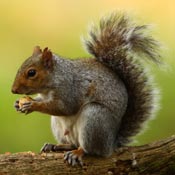Squirrels and squirrel biology

Grey squirrel
Grey squirrels (Sciurus carolinensis) are not native to the UK. They were introduced from North America in the 19th century and are now considered an invasive pest. They are very common in urban areas and parks were trees are present.
Grey squirrels are highly adaptable, unlike it’s native red cousin (Sciurus vulgaris). In contrast, they require a habitat which is very specific. Decline and the removal of the red squirrel is caused by grey’s presence. Grey squirrels are also carriers of pox, to which red squirrels succumb. However grey’s have an intrinsic resistance for this virus. This is also an important reason to get rid of grey’s and implement a control programme.
Red squirrels are protected under the Wildlife and Countryside Act 1981. In contrast, grey squirrels are classed as a non-native invasive pest species. Because of this live-trapped grey squirrels cannot be released!
Grey squirrels build nests made up of branches and leaves high up in trees, called dreys. They are used for protection and for breeding. Litters of approximately 3 young are born after a gestation period of 1.5 months. They leave the nest in June. A second litter of young grey squirrels is produced which leave the nest late summer. Grey squirrels will be capable of breeding after at the age of 7-12 months and can live up to 10 years in the wild. However, the mean life expectancy is 2 years.
Squirrel damage and reasons to remove squirrels
The most serious squirrel damage is caused by typical rodent behavior which is gnawing. Once squirrels have found a way in roof spaces they can cause damage to wood and plaster work. In addition, they damage electrical wiring, causing a potential fire hazard and strip rock wool insulation from lofts to form a drey. Also, it is not uncommon for squirrels to drown in cold water storage tanks to contaminate water with a putrefying carcass.
In forestry effective control is vital as they can stip bark from trees. This can cause trees to die or result in a malformed trunk, thereby reducing the commercial value of timber. The damage caused are all valid incentives to remove squirrels.
Squirrel Catching, trapping, removal services in Wigan, Bolton, Preston and Liverpool
Proofing and reducing food supplies (preventing access to bird feeding tables can be a challenge) should always be a priority before lethal control methods are explored. Proofing includes blocking gaps with wire netting. A metal sleeve around saplings can prevent tree damage.
The method used by aardvark pest control technicians is the use of trapping and/or shooting (were appropriate) only. The use of any poison, including the use of 0.02% warfarin laced wheat bait – which has been discontinued since march 2018, is illegal.
We make sure we adhere to Animal Welfare Legislation and the Wildlife and Countryside Act 1981 . This means for example that traps have to be checked at least once a day, at intervals of no more than 24 hours. Any grey squirrel caught must be swiftly and humanely dispatched.
In addition, when certain traps are used, every possible precaution must be performed to prevent killing of non-target species. This includes the setting of the trap in a natural or artificial tunnel. Traps must be checked daily.
Please contact us for a quote if you require expert squirrel control.
